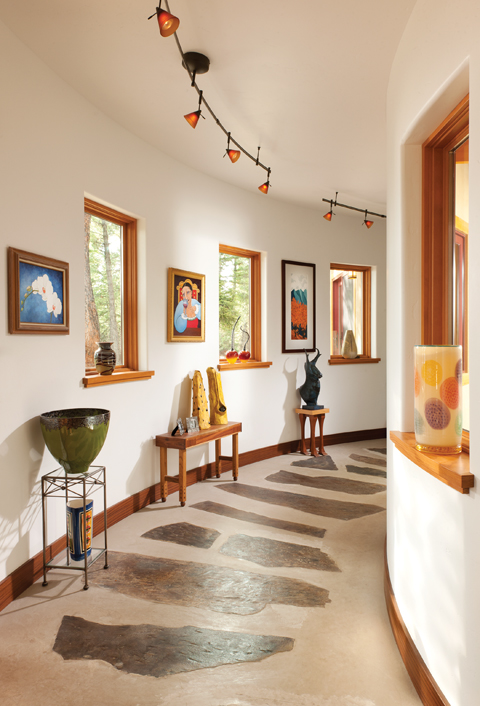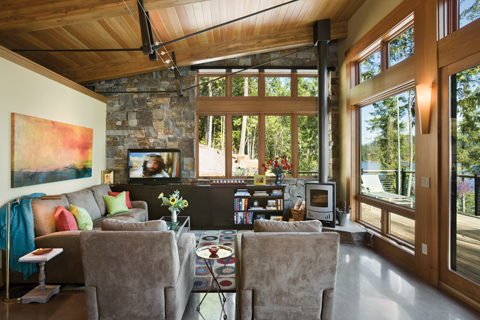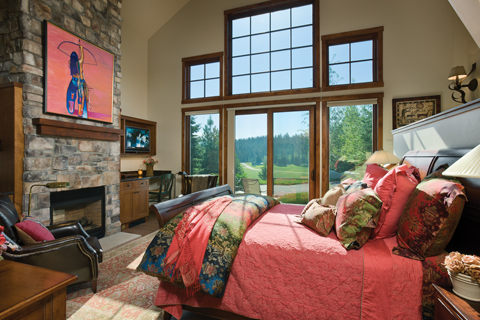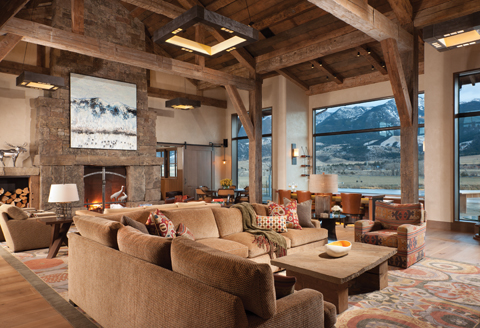Art, whether it’s a painting, sculpture, photograph, poster, pottery, art glass, quilt, or other medium, will both enhance and personalize your home. It can serve as a focal point and conversation starter, ground or brighten a space, and add color and texture to a room. Selecting artwork for your home is a matter of personal preference and taste, and your choices speak to who you are and what your interests are. The most important thing about art is that you love it and enjoy looking at it every day.
There are two approaches to placing artwork in your home. If you are staring with a blank canvas and do not possess any art pieces you love or think are appropriate for your log or timber home, then the world of art is wide open for you. If, on the other hand, you have a collection of any type, whether it be paintings, American Indian artifacts, or pottery, that you want to display in your new home, then you’ll want to consider where and how to display it during the design process. Perhaps you are transferring your collection from one home to another, or you have been dreaming of a log or timber home for years and have been gathering items in anticipation.

Photo by Heidi Long
Starting from Scratch
It’s helpful to begin thinking about your décor at the home design phase. Start with key spaces where you will want to place a piece of art that will attract attention without detracting from the beautiful structure of the home. Probably the most important spot is over the fireplace. If you’re building a home with a floor-to-ceiling stone fireplace, a bright-colored painting, poster, or photograph with large areas of solid color would provide a nice contrast to the texture of the stone. Or, select a piece that calls to mind the views out the great room windows, perhaps a mountain or lake scene or even an indigenous animal. If you’re building in the West, a Navajo rug or Native American leather shirt would evoke the area’s past. If your family loves winter sports, consider a vintage travel poster that celebrates skiing or sledding. This will tie in your interests with the location of your home. Whatever you select should have aesthetic as well as personal appeal.
Once you have found the focal art of the room, find other pieces that complement it. You’ll want to look for things that have some connection to the main artwork in terms of pattern, color, or theme. Consider other works by the same artist or pieces that are done in a similar style. This is also an opportunity to add a different medium into the mix, such as pottery, glass, or metal. For example, if the painting over your fireplace depicts a Western scene, using a metal or wood sculpture of a Western animal, Native American figure, or even a cowboy would add to the overall style of the home. Smaller paintings or photographs can be grouped together for more impact, and glass pieces and small sculptures can be tucked into bookshelves or placed on tables around the room.
The dining room is another great spot for a show-stopping piece of art. In general, artwork should be hung at eye level for optimum viewing, but in a dining area you’ll see the pieces from your seat at the table, so they should be hung slightly lower. Consider hanging a mirror of a similar size and shape on the wall opposite the art piece. That way, no matter where you are seated you’ll be able to enjoy the piece.
Many interior designers advise selecting your major art pieces before you plan the rest of the home’s décor. Ideally, the furniture, rugs, and other accessories will enhance your artwork. You can draw a color or pattern from a painting, poster, or photograph and use it sparingly in other areas to give the room a cohesive and pleasing appeal. If you have log walls and a natural stone fireplace, but have selected some lighter, more colorful artwork, you’ll want to keep the rugs and furniture fairly neutral so the art takes center stage. If you have opted for some sheetrock in your log or timber frame home, you can select a striking color that enhances the structure and the art piece. Or let the art shine on a neutral, light-toned wall. The connection between the décor and the artwork does not need to be overemphasized, just subtly hinted at.

Reid Smith Architects/photo by Roger Wade
Housing a Collection
If you have an art collection of any kind and want to display it in the public areas of your new log or timber frame home, it’s important to discuss it with your architect and interior designer at the very beginning of the design process. Aside from strategically placing various pieces around the home, you may want to consider transforming a hallway into an art gallery, creating niches for specific sculptures, or building custom shelves for glass or pottery. In all cases, you will want to insure that the lighting is designed to highlight the art piece, it is protected from the sun, and any required temperatures are maintained to preserve the art. With advance knowledge of a collection, an architect and interior designer can use your collection in spectacular ways.
On the Hunt for Art
There is art of all types out there to fit any budget. On the high end, there are art galleries all over the country that specialize in investment-quality pieces. If you are spending a great deal of money, make sure you know what you are buying. If you have questions, it’s best to consult with an expert. If you are interested in regional art that will reflect your home’s location, look for smaller galleries in the surrounding towns. You’ll see everything from large-scale oil paintings to stone and metal sculpture to quilts created by people who know and love the area. Regional art will add to the ambience you are creating and support the local art community. Another good source for original art can be found online at www.etsy.com. A great many artists and photographers display their work for sale on the website, usually at very reasonable prices.
Vintage posters are both colorful and collectible. A number of online sources carry a variety of European and American travel posters, including www.vepca.com and www.chisholm-poster.com. Again, make sure you know what you are purchasing. Ideally, the poster should be in mint condition and backed with linen. If authentic vintage posters are not in your budget, www.art.com and other web outlets sell high-quality reproductions.

The Callard Company/photo by Roger Wade
Craft shows and arts festivals are another source for all types of art. Painters, sculptors, potters, glass blowers, metal workers, and quilters show their work and are happy to discuss it with you. You’ll find original work at these shows that can’t be found elsewhere.
If you are handy with a camera yourself, another possibility is to have some photographs of your property and the surrounding area framed for your home. If you want a large-format piece, a number of companies will take your digital photograph and blow it up to create a statement piece. You can have the photo printed on canvas and gallery wrapped so that it looks professional. You can also purchase a blank canvas or two at a local craft store and create your own masterpiece.
The Art of Transformation
Selecting the perfect piece of art for your home may seem stressful at first, but once you dive in it will prove to be both fun and rewarding. Although interior designers may list a number of rules and guidelines for buying and placing art, the most important thing is finding pieces that speak to you and your lifestyle. Log and timber frame homes are wonderful backdrops for artwork and should inspire your choices. You chose to build a log or timber frame home because you love the architecture. Adding art is the cherry on top.

